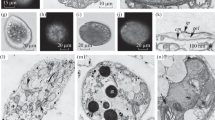Summary
-
1.
“Giant”, non-divinding cells of Chlorella are produced when synchronous cultures of the Emerson strain are maintained under heterotrophic conditions.
-
2.
The ultrastructural changes accompanying recovery of cell division when the ⇌giant” cells are returned to autotrophic conditions have been studied.
-
3.
The pattern of cell division is similar to that of autotrophically-grown cultures but with some special features, not hitherto recorded, which are probably related to the abnormally large number of autospores produced from each “giant” cell.
-
4.
The special features are associated with nuclear division, cell-plate formation and cell wall synthesis.
-
5.
The investigations show that the blockage of cell division under heterotrophic conditions does not involve a major disruption of the machinery for cell division, which can be reactivated to give normally-functioning autospores following transfer of the “giant” cells to autotrophic conditions.
Similar content being viewed by others
References
Aoki, S., Hase, E.: De- and re-generation of chloroplasts in the cells of Chlorella protothecoides. I. Synthesis of nucleic acids and protein in relation to the process of regeneration of chloroplasts. Pl. Cell Physiol. 5, 473–484 (1964).
Armstrong, J. J., Surzycki, S. J., Moll, B., Levine, R. P.: Genetic transcription and translation specifying chloroplast components in Chlamydomonas reinhardi. Biochemistry 10, 692–701 (1971).
Atkinson, A. W., Jr., Gunning, B. E. S., John, P. C. L., McCullough, W.: Centrioles and microtubules in Chlorella. Nature (New Biol.) 234, 24–25 (1971).
Bisalputra, T., Ashton, F. M., Weier, T. E.: Role of dictyosomes in wall formation during cell division of Chlorella vulgaris. Amer. J. Bot. 53, 213–216 (1966).
Falk, H.: Zum Feinbau von Botrydium granulatum Grev. (Xanthophyceae). Arch. Mikrobiol. 58, 212–227 (1967).
Falk, H., Kleinig, H.: Feinbau und Carotinoide von Tribonema (Xanthophyceae). Arch. Mikrobiol. 61, 347–362 (1968).
Griffiths, D. A., Griffiths, D. J.: The fine structure of autotrophic and heterotrophic cells of Chlorella vulgaris (Emerson strain). Pl. Cell Physiol. 10, 11–19 (1969).
Griffiths, D. J.: The growth of synthronous cultures of the Emerson strain of Chlorella vulgaris under heterotrophic conditions. Arch. Mikrobiol. 71, 60–66 (1970).
Lang, N. J.: Electron microscopy of the Volvocaceae andAstrephomenaceae. Amer. J. Bot. 50, 280–300 (1963).
Moor, H.: Die Gefrier-Fixation lebender Zellen und ihre Anwendung in der Elektronenmikroskopie. Z. Zellforsch. 62, 546–580 (1964).
Murakami, S., Morimura, Y., Takamiya, A.: Electron microscopic studies along cellular life cycle of Chlorella ellipsoidea. In: Studies on microalgae and photosynthetic bacteria, pp. 65–83. Tokyo: Univ. Tokyo Press 1963.
Ohad, I., Siekevitz, P., Palade, G. E.: Biogenesis of chloroplast membranes. I. Plastid dedifferentiation in a dark-grown algal mutant (Chlamydomonas reinhardi). J. Cell Biol. 35, 521–552 (1967).
Ohad, I., Siekevitz, P., Palade, G. E.: Biogenesis of chloroplast membranes. II. Plastid differentiation during greening of a dark-grown algal mutant (Chlamydomonas reinhardi). J. Cell Biol. 35, 553–584 (1967).
Reynolds, E. S.: Use of lead citrate at high pH as an electron opaque stain in microscopy. J. Cell Biol. 17, 208–212 (1965).
Schiff, J. A., Epstein, H. T.: The continuity of the chloroplast in Euglena. In: The biology of Euglena, Vol. II, D. E. Buetow, ed. pp. 285–333. New York: Academic Press 1968.
Soeder, C. J.: Elektronenmikroskopische Untersuchung der Protoplastenteilung bei Chlorella fusca Shihira et Krauss. Arch. Mikrobiol. 50, 368–377 (1965).
Spurr, A. R.: A low-viscosity epoxy resin embedding medium for electron microscopy. J. Ultrastruct. Res. 26, 31–43 (1969).
Staehelin, A.: Die Ultrastruktur der Zellwand und des Chloroplasten von Chlorella. Z. Zellforsch. 74, 325–350 (1966).
Thinh, L. V., Griffiths, D. J.: Physiological changes accompanying the recovery of cell division in “giant” cells of Chlorella vulgaris (Emerson strain). Pl. Cell Physiol. 11, 621–629 (1970).
Thinh, L. V., Griffiths, D. J.: The contrasting effects of chloramphenicol and cycloheximide on the recovery of cell division and chlorophyll synthesis in “giant” cells of Chlorella vulgaris (Emerson strain). Pl. Cell Physiol. 12, 171–179 (1971).
Wanka, F.: Ultrastructural changes during normal and colchicine-inhibited cell division of Chlorella. Protoplasma (Wien) 66, 105–130 (1968).
Author information
Authors and Affiliations
Rights and permissions
About this article
Cite this article
Van Thinh, L., Griffiths, D.J. Ultrastructural changes accompanying the recovery of “giant” cells of the Emerson strain of Chlorella. Archiv. Mikrobiol. 87, 47–60 (1972). https://doi.org/10.1007/BF00424778
Received:
Issue Date:
DOI: https://doi.org/10.1007/BF00424778




